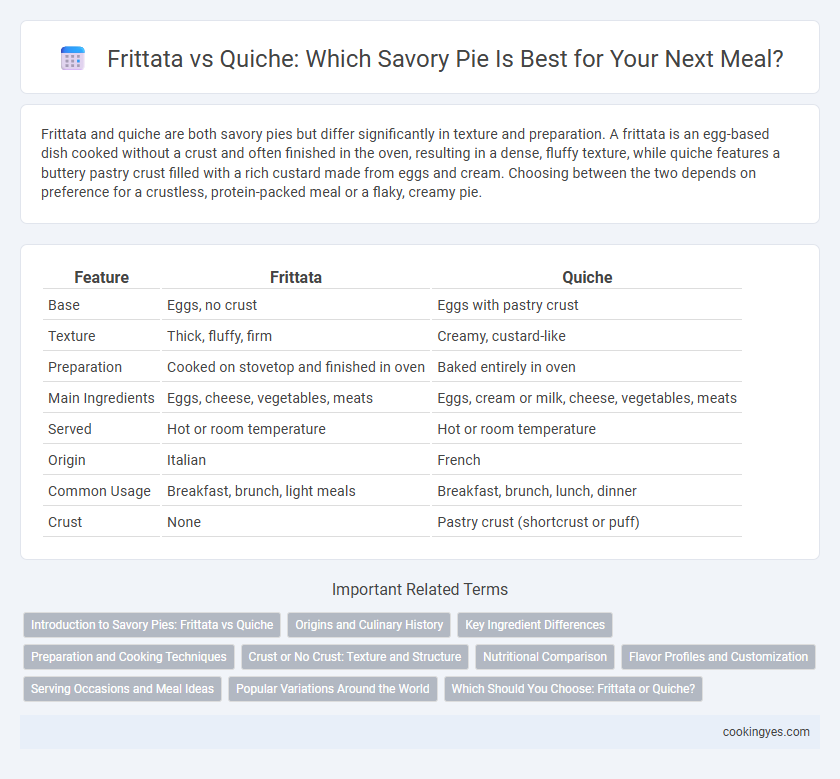Frittata and quiche are both savory pies but differ significantly in texture and preparation. A frittata is an egg-based dish cooked without a crust and often finished in the oven, resulting in a dense, fluffy texture, while quiche features a buttery pastry crust filled with a rich custard made from eggs and cream. Choosing between the two depends on preference for a crustless, protein-packed meal or a flaky, creamy pie.
Table of Comparison
| Feature | Frittata | Quiche |
|---|---|---|
| Base | Eggs, no crust | Eggs with pastry crust |
| Texture | Thick, fluffy, firm | Creamy, custard-like |
| Preparation | Cooked on stovetop and finished in oven | Baked entirely in oven |
| Main Ingredients | Eggs, cheese, vegetables, meats | Eggs, cream or milk, cheese, vegetables, meats |
| Served | Hot or room temperature | Hot or room temperature |
| Origin | Italian | French |
| Common Usage | Breakfast, brunch, light meals | Breakfast, brunch, lunch, dinner |
| Crust | None | Pastry crust (shortcrust or puff) |
Introduction to Savory Pies: Frittata vs Quiche
Frittata and quiche are popular savory pie options distinguished by their base ingredients and preparation methods. Frittatas rely on beaten eggs mixed directly with vegetables, meats, or cheeses without a crust, offering a lighter, more versatile dish. Quiches feature a buttery pastry crust filled with a custard of eggs, cream, and cheese, providing a rich, creamy texture that holds fillings firmly in place.
Origins and Culinary History
Frittata, an Italian dish rooted in ancient Roman cuisine, is a traditional egg-based pie that emphasizes simplicity and rustic flavors without relying on a crust. In contrast, quiche originated in France, specifically the Lorraine region, during the 16th century, evolving from a savory custard pie baked in a pastry shell. The culinary history of frittata highlights its role as a versatile, no-crust egg dish designed for resourceful cooking, while quiche reflects refined French baking techniques integrating rich cream and pastry dough.
Key Ingredient Differences
Frittatas rely primarily on eggs mixed with vegetables, cheese, and sometimes meats, without a crust, creating a dense and protein-rich base. Quiches use a custard filling of eggs and cream or milk, which provides a richer, creamier texture, and are baked in a flaky pastry crust. The key ingredient difference lies in the absence of crust in frittatas and the use of dairy for a custard-like consistency in quiches.
Preparation and Cooking Techniques
Frittatas are prepared by beating eggs and mixing them with vegetables, cheese, or meats, then cooking slowly over low heat on the stovetop without a crust, allowing for a creamy texture. Quiches require a pre-baked pastry crust filled with a custard mixture of eggs, cream, and fillings, which is baked in the oven until set and golden. The frittata's stovetop-to-oven technique contrasts with quiche's entirely baked method, affecting texture and preparation time.
Crust or No Crust: Texture and Structure
Frittatas feature a crustless structure, resulting in a denser, more custard-like texture compared to quiches, which rely on a flaky, buttery crust that adds a crisp contrast to the creamy filling. The absence of crust in frittatas emphasizes the cohesive blend of eggs, cheese, and vegetables, creating a uniform, tender bite, while quiches offer a layered experience with a firm, crumbly base supporting a soft, savory custard. Choosing between frittata and quiche hinges on texture preference--opting for a softer, crust-free dish or a buttery crust that enhances structural integrity and mouthfeel.
Nutritional Comparison
Frittatas are typically lower in carbohydrates and calories compared to quiches due to the absence of a crust, making them a lighter option for savory pies. They are rich in protein and healthy fats from eggs and fillings like vegetables and cheese, promoting muscle health and satiety. Quiches often contain higher fat content and calories because of the buttery pastry crust and added cream, which can increase saturated fat intake.
Flavor Profiles and Customization
Frittatas offer a bold, egg-forward flavor with a creamy texture that absorbs a wide range of ingredients, making them highly customizable for savory pies. Quiches feature a delicate, buttery crust paired with a custard-like filling that blends eggs, cream, and cheese for a rich, smooth profile. Customization in frittatas allows for layering diverse vegetables, meats, and cheeses without crust constraints, while quiches rely on the balance between filling and crust to enhance flavor complexity.
Serving Occasions and Meal Ideas
Frittatas offer a versatile option for breakfast, brunch, or light dinners, perfectly suited for casual gatherings or quick meals, while quiches provide a richer, more formal dish ideal for holiday celebrations and elegant brunches. Savory pies like frittatas are easily customized with seasonal vegetables, cheeses, and proteins, making them excellent for weeknight dinners or potluck events. Quiches typically contain a buttery crust and cream-based filling, giving them a luxurious texture that pairs well with salad sides and wine for upscale occasions.
Popular Variations Around the World
Frittata features a fluffy, egg-based structure without a crust, making it popular in Italian cuisine where ingredients like potatoes, cheese, and vegetables are commonly incorporated. Quiche, known for its buttery pastry crust filled with a creamy custard of eggs and cream, is a staple in French cooking with variations such as Quiche Lorraine containing bacon and Swiss cheese. Worldwide adaptations of frittata include Spain's Tortilla Espanola, while quiche inspires regional versions with diverse fillings and crusts, highlighting their distinct textures and ingredient profiles in savory pies.
Which Should You Choose: Frittata or Quiche?
Frittatas offer a lighter, crustless option rich in eggs and versatile fillings, ideal for those seeking a quick, protein-packed savory pie without added carbohydrates. Quiches, featuring a buttery pastry crust and a creamy custard base, deliver a richer texture and are perfect for leisurely meals or elegant brunches. Choose a frittata for simplicity and low-carb benefits, while quiche suits occasions demanding a more indulgent, traditional savory pie experience.
Frittata vs Quiche for Savory Pies Infographic

 cookingyes.com
cookingyes.com